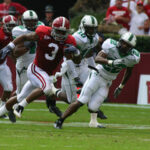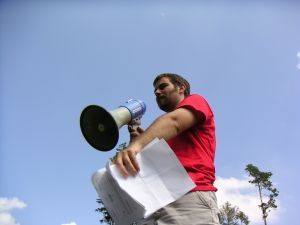The Mexican and the American Dream: Gary Soto’s “When Mexicans Begin Jogging”
When readers get their first taste of Gary Soto’s poetry they must savor its authentic seasoning of ethnic spice– Soto’s Mexican voice is distinctly clear. In “Mexicans Begin Jogging” the audience is treated to a wide range of
flavorful vehicles of comedy that are quintessential to Soto’s writings: identity, imagery, and irony all rich with individualistic stoicism and deep-rooted heritage. But for the author’s narration to be fully appreciated, the audience must understand the situations and sensations that surround the Mexican-American livelihood and must foremost explicate his texts from a
sociological perspective.
“Mexicans Begin Jogging” begins by placing the reader into the shoes of the author, or in this case, the work boots. Soto is working the factory’s press, as he did in his youth; an industrial job not uncommon for illegal immigrants whom have come to in pursuit of a better lifestyle. So when ‘La Migra’ (Spanish slang for the border patrol) show up everyone must run to escape possible deportation. That is, everyone except Soto. His boss commands him to jump the fence, like the others, and run, but he is unconvincing. He eventually must pay him to flee. This is the first point of conflict in the
poem.
Soto had pleaded with his boss that he was, in fact, American yet he was turned loose with the rest of the illegals and accused of being a liar. This evokes an all too similar sentiment for many foreigners whom reside in the alienation. Yet it runs much deeper than a simple but bad case of cultural xenophobia. Here we have a conflict of identity: Soto is Mexican at heart but American in mind– something his White boss will never understand. Rather than explain this to the White man and give him his money back, he runs (and takes the rest of the work day off).
He runs “past the amazed crowds… from the industrial road to the soft houses where people paled at the turn of an autumn sky.” (ll. 13-16) This is where Soto’s rich imagery comes into play. We can see the faces of the people on the street
as Soto tears by them in his steel-toed boots and that amazement serves as a transition into the suburbs’ collective reaction. Anyone jogging through a neighborhood wearing anything but jogging shoes and a uniform with 3 white stripes is certainly out of place. In a comical twist, Soto can’t help but “yell vivas” at the absurdity (l. 17). Although he is a meager, Mexican working
man who is out of his element he must call attention to the setbacks of the suburbanites: their houses are ‘soft,’ unlike those belonging to the hardened working class; their skin is ‘paled’ unlike that of the darkened peasants working to bring in the fall’s harvest.
Soto never needed to run, but he will continue “…as I jog into the next century on the power of a great, silly grin.” (ll. 20-21) He states this ironically “to baseball, milkshakes, and those sociologists who would clock me…” (ll. 18-19) embracing the fact that many Mexican Americans, and practically all illegal immigrants as well, will continue to chase after the American dream
in this similar fashion: in their work boots, over the White man’s turf, forever considered problematic to society. Like Soto, they will grin and dream on.
“Mexicans Begin Jogging” is proof within itself that readers must consider Gary Soto a sociologist. Perhaps he may not provide his data with any specifically scientific method, but his work will forever remain a landmark of the Mexican
American culture.




